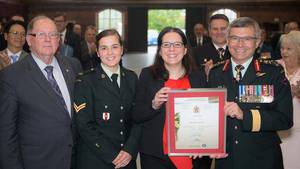 |
| Dr. Sultan Darvesh, director of the Maritime Brain Tissue Bank, compares a brain affected by Alzheimer’s disease (left) with a healthy brain (right). (Darren Hubley) |
Dementia comes in many shapes and sizes and is characterized by memory loss, impaired communication and reduced ability to focus. For dementia disorders such as Alzheimer’s disease, an accurate diagnosis cannot be made without an autopsy. Being able to diagnose these disorders early in their development would be a huge step forward in managing the disease and finding a cure.
“When we see people in the clinic, we make a diagnosis of dementia and then we categorize that,” says Dr. Sultan Darvesh, a cognitive behavioural neurologist at the QEII Health Sciences Centre. “Almost all the clinics around the world are certain that 80 to 90 per cent of their diagnoses of Alzheimer’s disease are correct, but never 100 per cent sure.”
But Dr. Darvesh is working on a way to change that.
He is also the director of the Maritime Brain Tissue Bank, where brain tissues from across the Maritimes are donated for research. Through his research Dr. Darvesh has confirmed that the enzyme butyrylcholinesterase (BChE) could lead to early detection of Alzheimer’s in living patients.
BChE is one of many proteins found in association with amyloid plaques, toxic abnormal clusters of proteins found predominately within the brains of people with Alzheimer’s disease. By detecting this protein through diagnostic imaging, he hopes to effectively increase the accuracy of Alzheimer’s disease diagnoses during life.
“We have been synthesizing molecules that bind to BChE and can distinguish Alzheimer’s disease from everything else,” says Dr. Darvesh, who is partnering with the QEII and the Biomedical Translational Imaging Centre (BIOTIC) to perform pre-clincial trials on laboratory animal models, before beginning clinical trials in the near future.
This discovery could be a major leap forward in the battle against Alzheimer’s disease. A viable early detection method will help physicians, like Dr. Darvesh, to treat their patients earlier and more effectively manage their symptoms. Not only that, but it could one day lead to a cure.
“If we’re able to find a method that is more definitive in the diagnosis of Alzheimer’s disease, then we would be able to enroll people in clinical trials to look for curative approaches to Alzheimer’s disease,” says Dr. Darvesh.
But this research, and all future research towards finding a cure for Alzheimer’s disease, depends on patients and their families submitting to the autopsy process and donating tissue, according to Dr. Darvesh.
“We will not find a cause or cure for Alzheimer’s disease unless we look at human brain tissues and that has to come from somewhere,” says Dr. Darvesh, who receives the majority of the tissue bank’s donations from the QEII. “You have to go through the autopsy process.”
To find out more about the Maritime Brain Tissue Bank and how you can help, visit braintissuebank.dal.ca.








